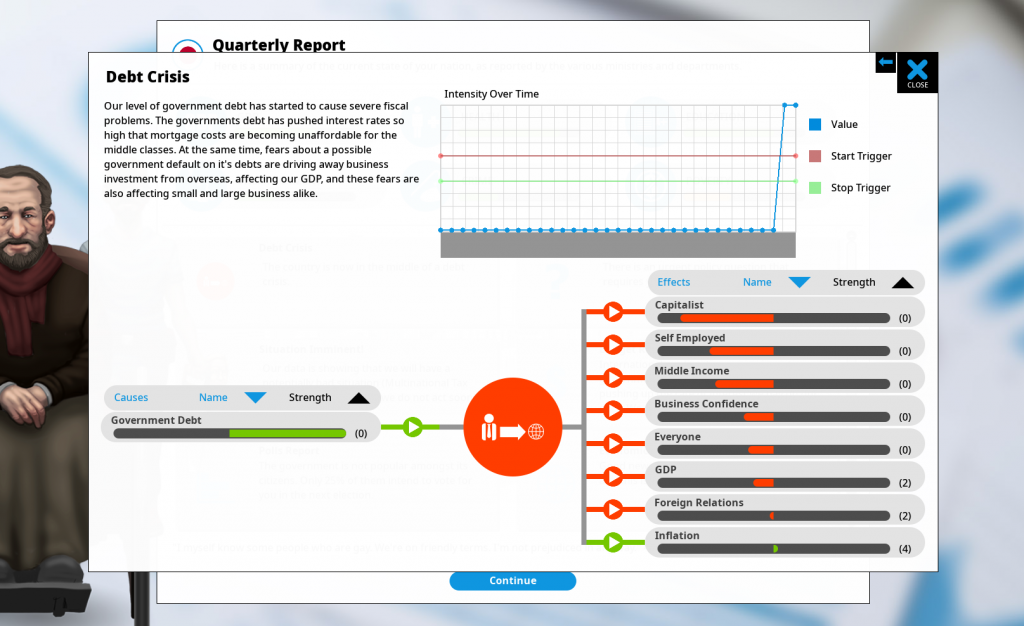So… I am currently working on adding Japan as a playable country to Democracy 4, which is still in Early Access. Although I think Japan is super interesting in many ways, especially cultural (very conservative on prisons, super-generous on maternity leave, amazingly high percentage of retired people, very high tech, super-low immigration…), its economics are absolutely batshit crazy. Lets look at some numbers.
The current GDP of Japan is 559 trillion yen and its debt is currently 1.328 quadrillion yen, which gives us a debt to GDP ratio of 237%. The country in 2019 (pre-covid) had a deficit of 17 trillion yen. Compare this to the USA in 2019 which had a GDP of $21 trillion, debt of $22trillion, which is a ratio of 104% and a deficit of under $1trillion.
The USA has the dollar, which is the reserve country of the whole world, and I think its fair to say both countries have fairly similar stability in political terms. They are both monetizing this debt by using some form of quantitative easing. The US flirts with helicopter money, but the amounts are relatively small. I think its fair to say the biggest difference between the two is that the US debt to GDP ratio is dramatically lower than that of Japan. In other words, its riskier to lend money to Japans government than the US< by quite a margin, as the economy of Japan looks way less likely to repay that debt than the US. This *should* be reflected in the interest people demand to lend to Japan. lets look at 10 year government bonds:
United States 10 year bond yield: 1.59%
Japan 10 year bond yield: 0.09%
HELP. At this point I feel that someone like me with a decent (but hardly expert) understanding of economics is basically in this position:
This makes no sense. Would you lend any money to the US government for just 1.59% return? me neither, especially when just splatting the money onto the S&P500 would get you 13.6% a year over the last 10 years, but OMG why on earth would anybody lend money to the Japanese government for 0.09%. It makes no sense, and much more fundamnetally than this..it breaks the simulation for my game Democracy 4!
Basically the game has hard coded into it the attitude of the international bond market when it comes to government debt. The general principles of the code are that every six months the bond market evaluates your country and looks at the debt/gdp ratio, the deficit/gdp ratio, the level of ‘stability’ and inflation in the country, and then decides on what the credit rating should be. The interest rate on the debt is then applied, based on that credit rating. The game assumes that the maximum conceivable debt/GDP ratio is 250% (Japan has broken this!). As the game stands right now, a few turns into a new game on Japan instantly triggers a really bad debt crisis:

The game also assumes that this upsets everybody, really badly, but in fact, this may be outdated because it seems that people generally seem very unconcerned by the size of japans debt. This is possibly because right now the world has other concerns with covid, and also because we have had a post-2008 general global credit crunch which has meant global use of QE to the extent that global interest rates have collapsed. Every country has bad debt and low interest rates, which maybe makes japan look not so crazy…
But it still should be WAY worse than the USA. Japan *is* in a debt crisis, and the way in which it seems to be given a free pass on staggering levels of debt is baffling…and yet this needs to be somehow handled in democracy 4… Hence we reading a lot, and looking for some justifiable ‘fudge factor’ I can code into the game that justifies all this. By any standard Japans credit rating should be something like D right now. In fact… its A.
The clearest explanation i have found so far is “A large portion of wealth is held by seniors who lack financial literacy and prioritize stability rather than return” (source). This also states that most Japanese govt debt is owned by Japanese citizens. This kind of implies I need to hard-code in something that says ‘Japanese tendency to not realize they are making shit investments’, as a modifier to boost the credit rating of Japan. That can’t be right!
There is an argument for saying that the country is more stable, and less vulnerable to external pressure on its debt because its mostly owned by its own citizens. The current economics of the game are actually giving Japans super-high debt about the right impact on the finances, so the problem is mostly that the debt crisis is triggering when it probably should be put off a bit by these factors.
So I suspect my actual solution here is to add a special modifier (domestic debt ownership) for the debt crisis situation , but leave the credit rating and interest rate stuff alone. I suspect this works because although the current bond yield on japans debt is super low, some of it will be much older and potentially paying out higher amounts.
Anyway….fun fun fun. I guess its different to balancing games with laser guns and magic spells.